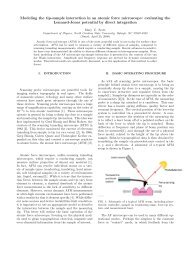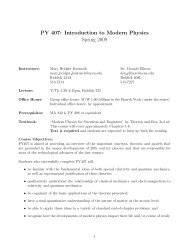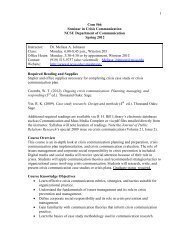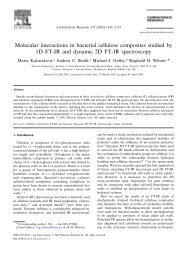Summary Frames Teaching Strategy
Summary Frames Teaching Strategy
Summary Frames Teaching Strategy
Create successful ePaper yourself
Turn your PDF publications into a flip-book with our unique Google optimized e-Paper software.
<strong>Summary</strong> <strong>Frames</strong> <strong>Teaching</strong> <strong>Strategy</strong><br />
Reference<br />
Honnert, A.M. & Bozan, S.E. (2005). Language Acquisition for Special Education and ELL<br />
Students. Science Activities, 42, 19-29.<br />
<strong>Summary</strong> & Procedure<br />
A student's ability to summarize information that is given in the form of written notes, reading<br />
assignments, and class discussions is essential to their retention of content information. Students who are<br />
unable to summarize the information presented become bogged down in writing every detail, thus failing to<br />
record all class instructional materials. Summarization is particularly difficult for Special Education and<br />
English Language Learners who are still developing their writing skills and possess a low vocabulary.<br />
The summary frame strategy is used to increase the students' abilities to acquire and use information<br />
and better comprehend science concepts. The summary frame also enhances the students' ability to apply<br />
information to discussions, laboratory reports and projects. <strong>Summary</strong> frames are a series of questions the<br />
teachers provide to the students. There are several models that may be utilized: Narrative Frame, Topic-<br />
Restriction-Illustration Frame, Definition Frame, Argumentation Frame, Problem/Solution Frame and the<br />
Conversation Frame.<br />
We will explore the procedure of the definition frame. Students are presented the vocabulary and are<br />
given index cards to record the word and its definition at the onset of a lesson. Students then create nonlinguistic<br />
representations of the vocabulary by skimming their textbooks for pictures, diagrams or models.<br />
The teacher orally presents a vocabulary word and the students hold up the correct card. For each chapter<br />
section, the class reads the material, highlights the main ideas and supporting details, clarifies the concept<br />
and presents concrete examples to connect personal experiences and knowledge.<br />
Students are given summary frames for specific topics (ie. What are the main cell parts). Students work<br />
in small groups to answer the questions in complete sentences. The students are able to utilize their<br />
highlighted text to answer the questions. After completing the questions, students summarize the<br />
information at the bottom of the worksheet. Students share their paragraphs and make corrections as<br />
necessary. They also check that the paragraph flows, it covers all the main ideas and it is in their own<br />
words when possible. Once the summary frames are completed, the students may utilize this information in<br />
further application assignments.<br />
Population Using this <strong>Strategy</strong><br />
Seventh grade middle school science students. Class of twenty-five students, three students with<br />
disabilities, twenty-two students without disabilities. The three students with disabilities are diagnosed as<br />
follows, behavioral emotional disorder (BED), learning disability reading comprehension, written language,<br />
math-problem solving (LD), English language learner (ELL).<br />
Potential Difficulties with the <strong>Strategy</strong>
The article addresses some possible issues that can occur from implementing this strategy. The first<br />
issue is that students may rush through the creation of their sentences not giving enough support and<br />
meaning so the sentences can be used properly in the summary portion. There is also the potential of<br />
greater frustration by students with limited vocabulary and writing skills when doing the summary frames.<br />
This leads to more time needed to instruct students on how to answer the questions being asked.<br />
Going along with the issue of time is one of the issues I have with this strategy. This lesson really takes a<br />
great deal of time to accomplish in a manner that is fitting to for a general classroom. I am not sure if the<br />
amount of information covered each quarter would allow for so much time to be spent on one area of the<br />
subject matter. Another issue that may occur is the fact that inquiry based learning is the big thing at this<br />
time in schools. This particular strategy lays all the information out for the students not allowing them to<br />
explore the concept first and then develop the information around what was initially discovered. The final<br />
issue that arises when I think of this strategy is that it is very slow moving. I understand why it is designed<br />
that way but I feel a lot of students in the class might find most of the steps in this strategy to be rather<br />
elementary and this could lend itself to them not being tested or pushed intellectually during the use of this<br />
strategy.<br />
Detailed Description of How to Use the <strong>Strategy</strong><br />
At the onset of the lesson, the teacher will present the terminology or vocabulary that the students will<br />
create index cards for each word. The front side of the card will contain the word and the definition will be<br />
written on the back. The second step is for the students to preview the text looking for non-linguistic<br />
representations (pictures, diagrams, models, etc.) that will create a picture of the word which the students<br />
will draw on the index cards. The students will review the vocabulary daily at the beginning of class and<br />
throughout the remainder of the unit. Teachers can construct different types of reviews, such as placing all<br />
the cards with the word and picture facing up. then reading a definition and asking students to silently hold<br />
up the card containing the correct term. Once each student has found an answer, have one of the students<br />
read the card out loud.<br />
Next, the students will read read the text as a class, highlighting main ideas one paragraph at a time.<br />
This strategy aids the students in learning the main ideas of the paragraphs, as well as the supporting<br />
details. The class will then clarify the main concept and present examples that connect to their experiences<br />
and knowledge. The students will then repeat the previous two steps for each section of the unit. The<br />
teacher will then distribute teacher-made summary frames and the students are given instructions on how<br />
they are going to be used in class. The students are separated into small groups and begin working to<br />
complete the handout questions by using the high-lighted text. They are to answer each question in<br />
complete sentences and combine these into a summary paragraph. The students will require teacher<br />
guidance and sufficient time to complete this task. Once completed, the students will share their<br />
paragraphs and make revisions as necessary. The paragraphs should make sense, cover all main points,<br />
and if at all possible be written in their own words.<br />
In this particular lesson, the students are to complete an organelle responsibilities worksheet in pairs or<br />
as groups. They can use the summary frame paragraphs as a reference tool. Students will identify four of<br />
the major organelles, the three main parts of an animal cell and define each part and its responsibility within<br />
the cell. As a teacher you can take this opportunity to illustrate to the students how as they function as<br />
individual organelles in the classroom cell, changing roles and responsibilities each week. Students will<br />
realize that as organelles need to function properly for a cell to remain healthy, they, too, must do their part
for the classroom to work smoothly. In addition, as a culminating activity to the unit, the students were given<br />
the opportunity to create and present an unique cell model.<br />
Demonstration of <strong>Strategy</strong> Use<br />
(Each page has a number of bulleted points)<br />
Title Page:<br />
Language Acquisition for Special Education and ELL Students.<br />
Science Activities<br />
Purpose:<br />
• To improve students' ability to take notes.<br />
• To improve students' ability to summarize material.<br />
• To help students' better understand vocabulary.<br />
• To help students' understand the connection between vocabulary and actual function.<br />
Steps for implementation:<br />
• Introduce vocabulary and have students create index cards for each word.<br />
• Have student create illustrations on index cards.<br />
• Use cards to test student vocabulary knowledge.<br />
• Read text as a class, having students identify main ideas.<br />
• Clarify main ideas and give concrete examples that connect with students' lives.<br />
• Use summary frames in small groups.<br />
◦ Students answer specific question, using complete sentences.<br />
◦ These sentences are combined to create a summary of the information covered.<br />
• Use a graphic organizer so students can better explain each part of the given topic.<br />
◦ This can be performed in groups.<br />
• Students complete this portion using the summary frames.<br />
◦ Students understand how everything works together.<br />
• Students can make a model to better explain the information learned.<br />
• Give students class time to create models.<br />
• Models can be presented to the class.










